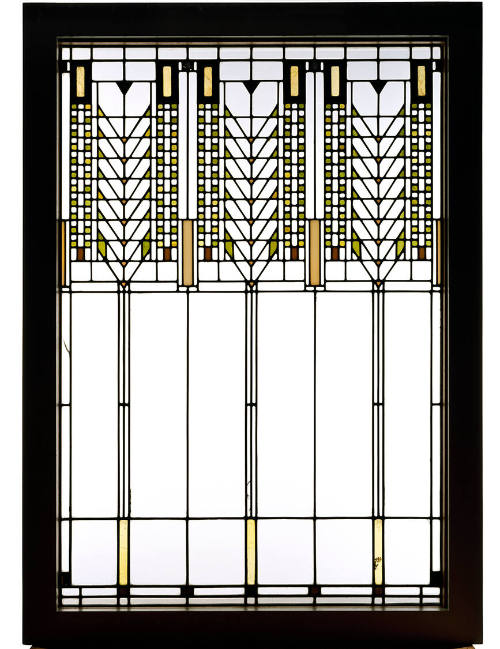- Open today, 10 am to 5 pm.
- Parking & Directions
- Free Admission

Window from Darwin D. Martin House
- Geometric
- Tree of Life
- Trees
- Colorless
- Green
- Yellow
American (1867-1959)
Linden Glass Company, Manufacturer
Chicago, Illinois
Modified Second-Floor Pattern Window from the Darwin D. Martin House, ca. 1903-09
Flat glass and brass
Museum purchase and gift of Walter P. Chrysler, Jr., by exchange 2003.21
Frank Lloyd Wright, one of America's most famous architects, made extensive use of leaded glass windows in many of the buildings that he designed between 1885 and 1923. This second-floor pattern window, designed in 1903, comes from the ground-floor reception room of the Darwin D. Martin House in Buffalo, New York. Originally, the lower portion of the window had a border of large opaque white squares, but Wright modified this and the other windows in that room in 1909 at Martin's request. The architect's drawing for this modification survives-documenting the only instance in which Wright is known to have altered windows after their installation.
Wright employed narrow brass cames with a triangular profile instead of traditional grooved lead rods to hold the pieces of glass in place. The strength and rigidity of the brass allowed the geometric pattern to be executed crisply, with a sense of delicacy that could not have been achieved in lead.
Light Screen from the Darwin D. Martin House
ca. 1903–9
Frank Lloyd Wright, designer
American, 1867–1959
Linden Glass Company, manufacturer
American, Chicago, 1890–1934
Leaded glass with brass cames
391/2 × 267/8 in.
(100.3 × 68.3 cm)
Museum purchase and gift of Walter P. Chrysler, Jr., by exchange, 2003.21
This window is an acclaimed glass design by Frank Lloyd Wright. Celebrated as one of America’s most innovative architects, Wright was a leading proponent of the distinctively American Prairie School of architecture, which emerged at the beginning of the twentieth century in Chicago and the Midwest. He designed this window for the Darwin D. Martin House in Buffalo, New York, which is considered a masterpiece in the Prairie House style.1 Wright called his window designs "light screens," and he created eleven patterns for the windows, doors, skylights, and laylights in the Martin house.2 Wright designed the home’s interior and all the furnishings, and he intended the light screens to be important components that would define the character of the space.
This light screen was one of a set of nine that formed a projecting bay window across from a massive brick fireplace in the first-floor reception room.3 Wright intended for the stylized abstraction of trees in the light screens to frame views of the surrounding landscape, thus uniting the interior space with the exterior. Wright did not consider the light screen to be an independent work of art; rather, he planned a series of light screens to form an uninterrupted expanse of glass that would complement the residence’s open floor plan.
While Wright referred to the light screens for the Martin house simply as first- and second-floor designs, historians have long referred to this pattern as "Tree of Life."4 The design consists of a vertical pattern of three plant forms with thin stems leading up to many branches. The light screen is unusual for its use of brass cames instead of lead to hold the pieces of translucent, iridescent, and transparent colorless glass in place.5 The accent colors of opalescent green, brown, yellow, and gold glass in the window harmonized with the earth tones in the color scheme of the interior and subtly echoed the golden-toned horizontal lines of the brick mortar in the walls.
Although leaded glass windows were popular in late nineteenth- and early twentieth-century homes in a variety of styles following the aesthetic of John La Farge (1835–1910) and Louis C. Tiffany (1848–1933), Wright’s vision for glass was a distinct departure from pictorial art glass windows.6 His restrained use of geometric patterns and considerable amounts of clear glass made transparency and abstractness distinctive elements of his designs. Wright worked with the Linden Glass Company in Chicago to fabricate his light screens for the Martin house. Although Wright’s design is
based on a simple geometric abstraction of a tree, this window consists of more than 750 individual pieces of glass, making its fabrication and assem-
bly a labor-intensive process. | msh
Notes
1. Darwin D. Martin (1865–1935) was president of the Larkin Company, a soap manufacturer, and one of Wright’s greatest patrons. The Darwin D. Martin House was designed and built between 1903 and 1905 and was deemed a National Historic Landmark in 1986. After the property was abandoned from about 1935 to 1950, three of the five buildings in the Martin complex were demolished in 1960.
2. Laylights are glass panels fitted into the ceiling and artificially lit from behind, like a false skylight.
3. At the client’s request in 1909, this pattern was slightly modified from that of related light screens from the second-floor bedroom.
4. Julie L. Sloan, Light Screens: The Leaded Glass of Frank Lloyd Wright (New York: Rizzoli International Publications in association with Exhibitions International, 2001), 80–82.
5. Wright used brass cames with triangular profiles for structural strength and rigidity instead of traditional lead rods.
6. For more on La Farge and Tiffany, see cats. 33, 40, 43, 46, and 47.
